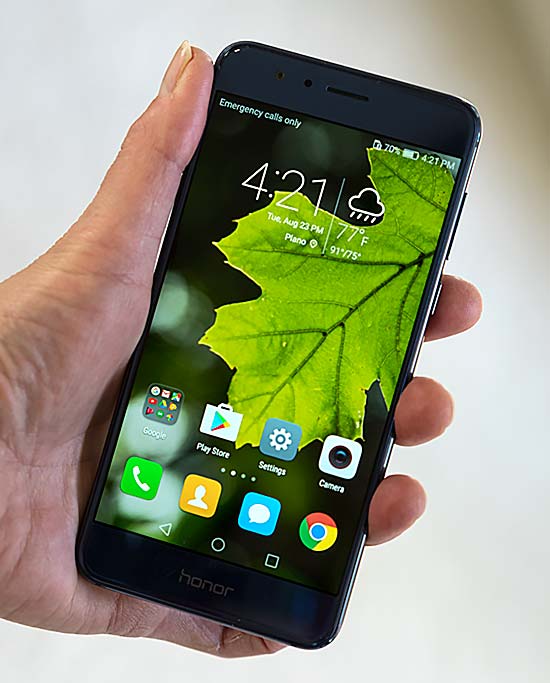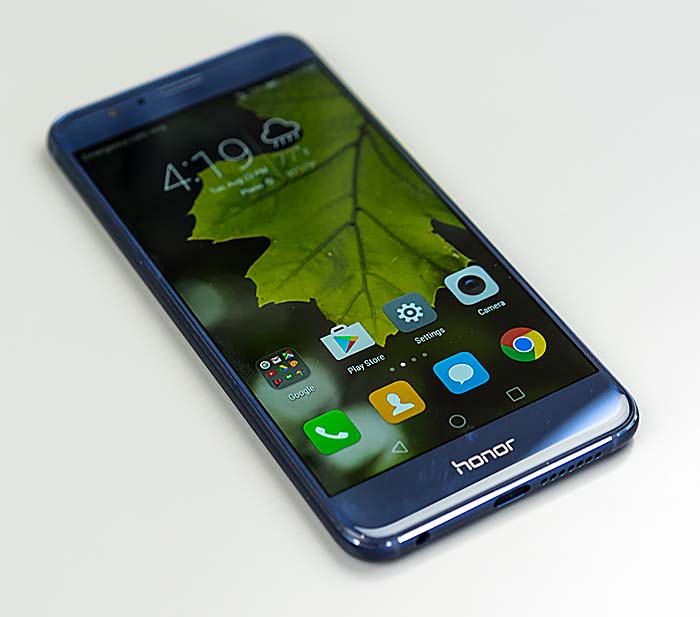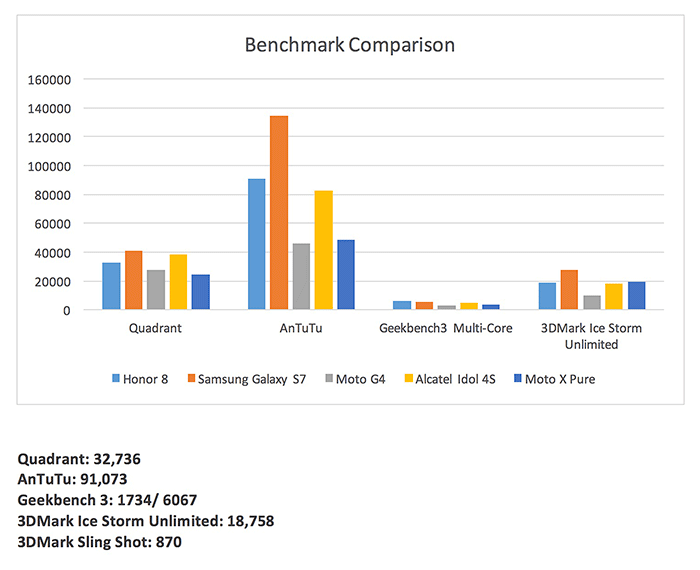|
2016 continues as the year of the affordable but really good Android phone, particularly unlocked models that are sold direct and via retailers rather than carriers. There's the OnePlus 3, Alcatel Idol 4S, ZTE Axon 7, the Moto G4/G4 Plus and now the Huawei Honor 8. The Honor sub-brand is Huawei's affordable line that targets Millennials, though I don't see why a 13 year old or 70 year old wouldn't also like the phone. It's a stunning looking phone clad in 2D glass and metal, and it's very pocketable at 5.2". The Android 6.0 Marshmallow smartphone flirts with high end design and features at a relatively modest $399 price tag for the 32 gig model (the 64 gig is $449). That's significantly less than carrier flagships and even Huawei's own P9, but it has the design, fit and finish of a flagship. Inside it's no slouch with a solid CPU, lovely full HD display, dual band WiFi 802.11ac, NFC and very good front and rear cameras. No, it's not as fast as a Samsung Galaxy S7, nor is camera quality quite as good, but for the price, that's more than fair, and performance is good enough for all but enthusiasts who must have the best. The phone even has an IR blaster AV remote that's compatible with 230,000 appliances and home AV gear, a relative rarity these days.
This is an unlocked GSM phone that works on AT&T and T-Mobile and their offshoot brands like GoPhone as well as many smaller regional carriers. It supports quite a few LTE 4G bands: 1/2/3/4/5/7/8/12/17/20. It's not compatible with CDMA carriers (Verizon and Sprint). It's sold direct by Huawei's HiHonor.com website, Amazon, Best Buy and other online retailers rather than via your carrier. Thus it has no carrier bloatware, though Huawei adds just a few removable apps like News Republic.

Design and Ergonomics
This is a simply stunning and compact phone that looks like the love child of the iPhone 6s and Samsung Galaxy S7. It's available in black, white and our dark blue model that's arguably the most unique and attractive. The phone's back and front are 2D glass (that means it has very subtle curves at the edges) and the sides are aluminum. There's no mention of Gorilla Glass here, but our phone is holding up fine so far. The back is comprised of 15 layers, and that creates the complex reflections and hue. Huawei has slim, minimalist soft TPU plastic cases if you wish to protect the back of the phone. The Honor 8's great looks belie its price, and the relatively small size will fit small hands and pockets. The back glass shows fingerprints like mad, as does that optional see-through tinted TPU case. A wipe on your cotton tee shirt or a micro-fiber cloth cleans it up easily.
The phone's decent but not stellar speaker is on the bottom, next to the USB-C charging and data transfer port and the 3.5mm headphone jack. The 3,000 mAh battery is sealed inside and there's a tray for the nano SIM and microSD card (removable with the usual paperclip or included poke tool). The fingerprint scanner is on the back, and it's one of the fastest and most reliable we've used-- it's up there with the iPhone 6s. Rest your finger on the scanner (no need to click) and the phone wakes up and unlocks instantly. That button can double as an applicaton launcher when the phone is unlocked.
Display
The LTPS (low temperature poly silicon) display is very similar to IPS in terms of viewing angles, contrast and potential brightness. It's essentially a variant of IPS, and it's sharp, very bright and has good viewing angles on the Honor 8. It's bright enough to see outdoors and color saturation is high, particularly for a device in this price range, with 96% of NTSC, which is a slightly different but equally challenging standard compared to Adobe RGB. It more than covers sRGB and is a vibrant and lovely display. Contrast is very good at 1500:1. We're fine with the 1920 x 1080 resolution when mated to a relatively small 5.2" panel. That's 423 PPI, which is quite high. Nice. Huawei offers a few nice touches including infinite color adjustments along with normal, cool and warm presets, and a blue light reduction setting for night use (an LCD's blue light may prevent you from sleeping well).

Performance and Horsepower
The in-house Hisilicon Kirin 950 8 core (4 low and 4 high power cores) CPU from Huawei is a capable upper mid-range mobile CPU that performs similarly to the Qualcomm Snapdragon 652 used in the Alcatel Idol 4S that's priced similarly. It falls well short of the Snapdragon 820 high end CPU used in the OnePlus 3 and ZTE Axon 7, but one could argue that the Honor 8 offers better looks and a friendlier retail presence than those two enthusiast-pleaser models. It's great that Huawei is designing CPUs, otherwise Qualcomm would have a near stranglehold on the market with Samsung's Exynos carrying the torch as the only competitor. The Kirin 950 has 4 Cortex A72 cores running at 2.3 GHz and 4 Cortex A53 cores running at 1.8 GHz, and it doesn't fall far behind the highest end Kirin 955 in performance. In use, the phone feels responsive and can handle today's top 3D games fluidly enough for an enjoyable experience.
The phone has 4 gigs of RAM and your choice of 32 or 64 gigs of internal storage plus a microSD card slot compatible with cards up to 128 gigs. The LTE Cat6 model is part of the Kirin chipset and it offers good LTE 4G performance on par with many carrier offerings.
Benchmarks

|
Deals and Shopping:
Advertisement
|

